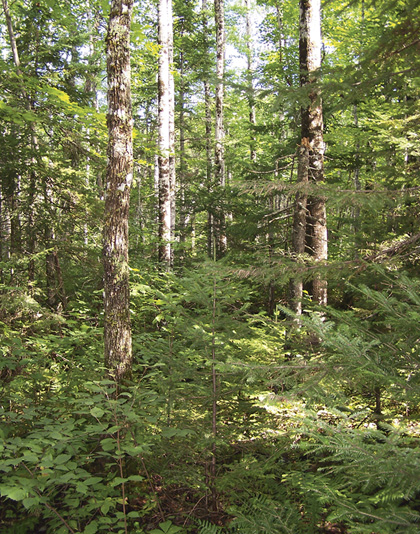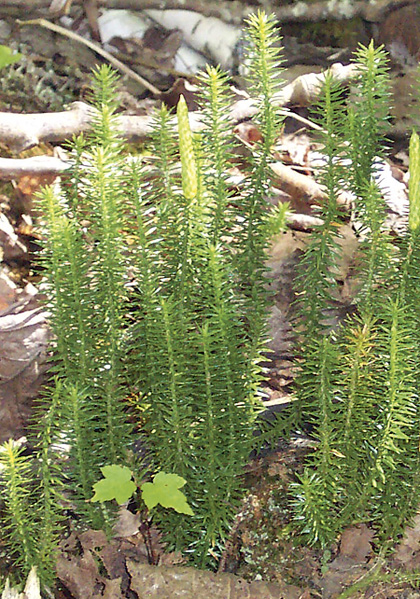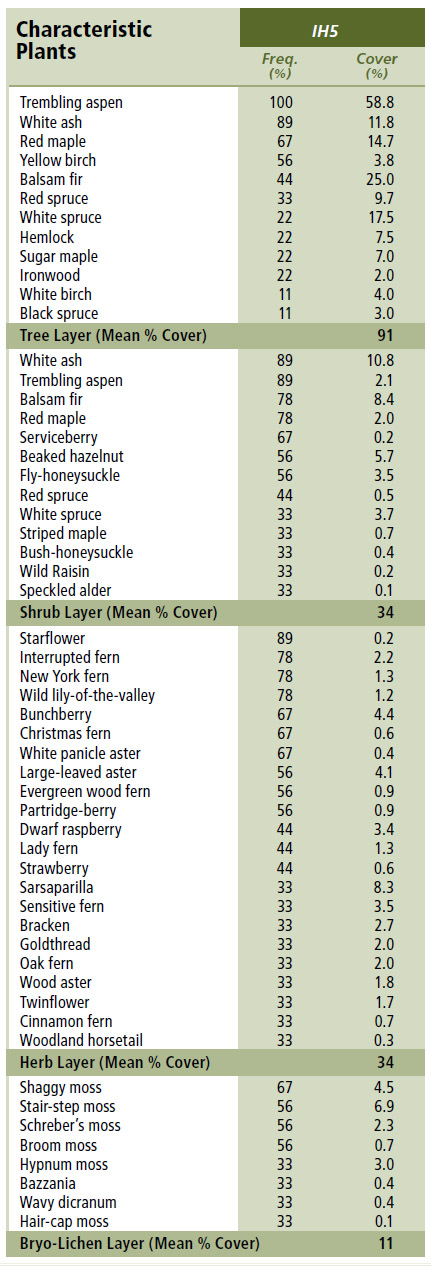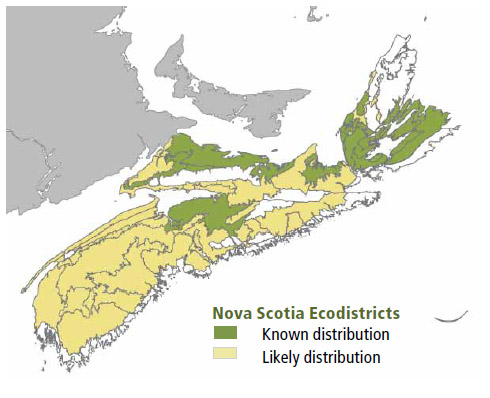
Forest Vegetation types - IH5
IH5 — Trembling aspen – White Ash /Beaked hazelnut / Christmas fern
Populus tremuloides – Fraxinus americana / Corylus cornuta / Polystichum acrostichoides
 |
Angevine Lake, Cumberland County |
Concept: This early to mid-successional Vegetation Type (VT) has an overstory co-dominated by trembling aspen and white ash with lesser amounts of red maple and yellow birch. It is similar to IH4 (Trembling aspen / Wild raisin / Bunchberry) but is found on somewhat richer sites, as evidenced by associated shifts in herbaceous cover and tree species composition. Trembling aspen – White ash / Beaked hazelnut / Christmas fern usually follows stand-replacing disturbance events such as fire, windthrow or clearcutting.
Vegetation: Trembling aspen dominates the overstory with a significant component of white ash. Lesser amounts of yellow birch, red maple, sugar maple and balsam fir are also common. The shrub layer is moderately developed and includes regenerating white ash and balsam fir along with beaked hazelnut and fly-honeysuckle. The herb layer has many plants indicative of moist and/or fertile site conditions including interrupted fern, New York fern, sensitive fern, Christmas fern, large-leaved aster and dwarf raspberry. Although the bryophyte layer is poorly developed, shaggy moss and stair-step moss are usually present.
Environmental Setting: IH5 is mainly associated with fresh to moist, nutrient medium to rich soils of variable texture. This VT is found primarily in the Valley/Central and Northumberland Bras d'Or Lowlands ecoregions. It is common in Prince Edward Island and in the warmer ecoregions of New Brunswick.
Successional Dynamics: IH5 is an early to mid-successional VT that follows stand-level disturbances in both softwood and hardwood forests. Typical disturbance agents include fire, windthrow and harvesting. IH5 stands are typically dominated by even-aged, clonal-origin trembling aspen. Depending on the intensity of disturbance, the aspen may perpetuate as an overstory component with little successional advancement of the stand. However, short-lived aspen deteriorate quickly due to natural senescence, insect predation, disease and/or wind damage. Later successional VTs are likely to remain hardwood dominated, although the presence of balsam fir and red spruce may move some stands to a mixedwood forest condition. Possible successional VTs include MW1 (Red spruce – Yellow birch / Evergreen wood fern), MW3 (Hemlock – Yellow birch / Evergreen wood fern), MW4 (Balsam fir – Red maple / Wood sorrel – Gold thread), SH3 (Red spruce – Hemlock / Wild lily-of-the-valley) and TH3 (Sugar maple – White ash / Christmas fern).
Ecological Features: This early successional small patch forest is short lived except for the white ash component that will continue into later successional stages. Trembling aspen is a very shade-intolerant tree and its regeneration is primarily through clonal reproduction from root suckers (which may also support large fungal associates such as shoe-string root rot). Aspen colonizes sites rapidly after stand-level disturbances. It acts as a “nurse crop” for later successional species that tend to grow up through the aspen, forming two-layered stands before the aspen is overtaken and dies out. Regenerating aspen stands provide cover and forage for many species. Moose and deer feed on its leaves and twigs, ruffed grouse eat its winter buds, snowshoe hare and mice consume its bark and twigs, and beavers make its bark a dietary staple. Resin from aspen buds is the primary source of bee propolis, an essential hive material. Older aspen trees provide soft snags and cavities for several species of birds. Aspen support many species of insects, most notably the forest tent caterpillar, which is an important food for birds and small mammals.
 |
| Bristly club-moss |
Distinguishing Features: These hardwood forests are dominated by trembling aspen with a component of white ash in the overstory, and with richer soils than IH4.
| Slope Position: | Lower5 Middle3 Toe1 Upper1 |
Surface Stoniness: |
(Non - Slightly)10 |
Bedrock Outcrop: |
(Non-rocky)10 |
Elevation Range: |
34 - 80m |
Slope Gradient: |
Gentle8 nd2 |
Aspect: |
North4 South5 nd1 |
Exposure: |
Moderate8 Mod. sheltered1 nd1 |
Microtopography: |
Slightly7 Moderately3 |
Drainage: |
Imperfect7 Moderately well3 |
Soil Type: |
ST94 ST62 ST122 ST81 ST161 |
Parent Material: |
Glacial till9 Alluvium1 |
Rooting Depth (cm): |
(<30)4 (30-45)3 (>45)1 nd2 |
Duff Thickness (cm): |
(0-5)5 (6-10)4 nd1 |

